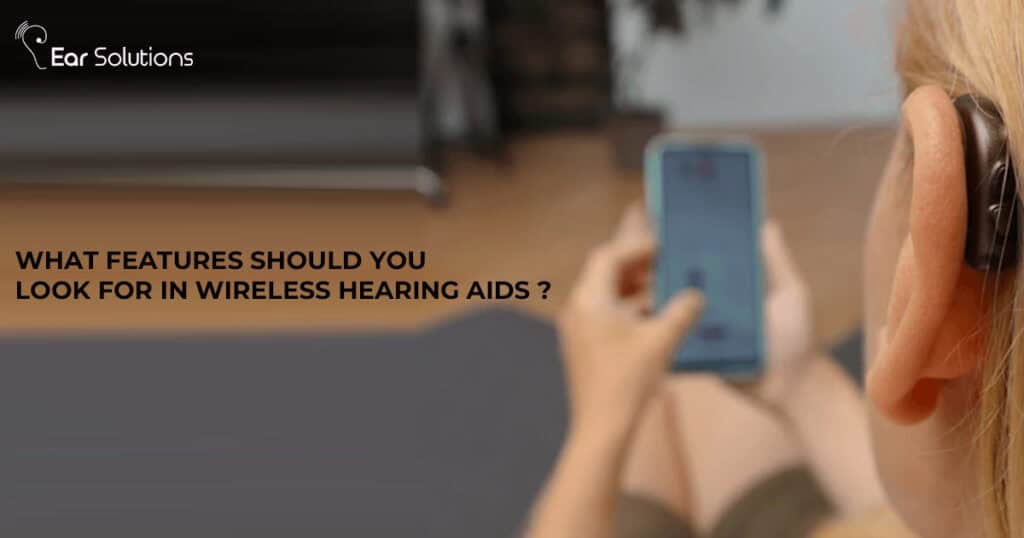Wireless hearing aids have changed the way people manage hearing loss by offering convenience, enhanced functionality, and an improved overall listening experience. These devices are equipped with advanced technology, making it easier for you to connect with various devices and environments, offering more control. But with so many options available on the market, it can be overwhelming to know what features are truly essential when choosing wireless hearing aids.
In this blog, we will know about some of the key features you should look for in wireless hearing aids to ensure you get the best performance, comfort, and value for your needs.
1. Bluetooth Connectivity
One of the most popular and beneficial features of wireless hearing aids is Bluetooth connectivity. Bluetooth-enabled hearing aids allow you to connect your hearing devices directly to other Bluetooth-compatible devices, such as smartphones, tablets, televisions, and computers. This feature enhances communication and entertainment by allowing you to stream audio directly to the hearing aids.
Why Bluetooth is important:
Phone calls: You can receive phone calls directly through your hearing aids without the need for headphones or holding the phone to your ears.
Music and media: Bluetooth allows for high-quality music streaming and media playback directly to the hearing aids, offering a more immersive experience.
Television: Watching TV becomes easier as audio is streamed directly to the hearing aids, eliminating background noise and ensuring clearer sound.
Bluetooth-enabled wireless hearing aids improve your ability to stay connected and engaged with your favourite devices without additional accessories.
2. Rechargeable Batteries
Rechargeable hearing aids are becoming increasingly popular, thanks to their convenience and eco-friendliness. Instead of frequently replacing disposable batteries, which can be costly, rechargeable wireless hearing aids allow you to simply place your hearing machines in a charging station overnight.
Benefits of rechargeable hearing aids:
Long-lasting battery life: Rechargeable hearing aids can last up to 24 hours on a single charge, ensuring power throughout the day.
Cost savings: Over time, you can save money by not having to buy replacement batteries regularly.
Environmental impact: Rechargeable hearing aids reduce the need for disposable batteries, making them a more eco-friendly choice.
For users who value simplicity and sustainability, rechargeable wireless hearing aids offer a hassle-free experience.
3. Noise Reduction and Sound Filtering
One of the most challenging aspects of hearing loss is the difficulty in distinguishing important sounds from background noise. Wireless hearing aid devices equipped with advanced noise reduction and sound filtering technologies make this easier by automatically adjusting to different environments, reducing unwanted noise, and enhancing the sounds that matter most.
Key sound filtering features to look for:
Directional microphones: These microphones focus on sounds coming from in front of the user while minimizing background noise from other directions. This is especially helpful in noisy environments, such as restaurants or crowded spaces.
Adaptive noise reduction: This feature reduces background noise, such as wind, traffic, or general ambient noise, making conversations and important sounds clearer.
Automatic sound adjustment: Many wireless ear machines automatically detect the surrounding noise levels and adjust the sound output accordingly, providing an optimized listening experience in various environments.
By choosing wireless hearing aids with noise reduction and sound filtering features, you can enjoy more comfortable and clear hearing in noisy settings.
4. App Integration
Most modern wireless hearing aids now come with app integration, allowing you to control and personalize your hearing machines through a smartphone app. This feature makes it easy to manage settings, monitor battery life, and adjust the sound profile to suit specific preferences.
Advantages of app integration:
Volume control: Users can easily adjust the volume of their hearing aids via the app, giving them greater control over their listening experience in different environments.
Sound customization: Many apps allow you to customize sound settings based on your preferences, such as enhancing speech clarity or focusing on specific frequencies.
Remote support: Some apps offer remote troubleshooting and support from audiologists, allowing you to get help without needing to visit a clinic.App integration makes managing hearing aids simpler and more intuitive, giving you more autonomy and flexibility in how to use the devices.
5. Telecoil (T-Coil) Technology
Telecoil, or T-coil technology, is a feature that allows wireless hearing aids to connect directly to hearing loop systems, commonly found in public spaces such as theatres, churches, airports, and conference rooms. These loops transmit sound signals directly to hearing aids, providing clearer audio without the interference of background noise.
Benefits of telecoil technology:
Better sound quality: T-coil technology delivers sound directly from the sound system to the hearing aid, bypassing any ambient noise in the environment.
Improved experience in public spaces: You can better enjoy events and announcements in venues equipped with hearing loop systems, making it easier to participate in social and public activities.If you frequently attend events or visit places with hearing loop systems, choosing wireless hearing aids with telecoil technology can greatly improve your experience.
6. Feedback Cancellation
Feedback, or the high-pitched whistling sound that sometimes occurs with hearing aids, can be both annoying and uncomfortable. Feedback cancellation technology in wireless hearing aids helps prevent these unwanted noises, providing a clearer and more comfortable listening experience.
Why feedback cancellation matters:
Prevents distractions: You can focus on important sounds without being interrupted by feedback noise.
Comfort in daily wear: Feedback can occur when hearing aids are placed incorrectly or when the volume is too high. Feedback cancellation automatically adjusts to prevent this, ensuring more comfortable daily use.
By opting for hearing devices with feedback cancellation, you can enjoy a more seamless and distraction-free listening experience.
Conclusion
Wireless hearing aids have come a long way in terms of technology, offering a range of features that can significantly enhance your listening experience. When choosing a wireless hearing aid, it’s essential to consider features like Bluetooth connectivity, rechargeable batteries, noise reduction, app integration, telecoil technology, and feedback cancellation.
By prioritizing these features, you can ensure that your wireless hearing aids meet your specific needs, whether you’re navigating busy public spaces, engaging in phone calls, or simply enjoying a quiet evening at home. Investing in the right wireless hearing aid can improve your overall hearing experience, providing you with greater independence and confidence in your daily life.





